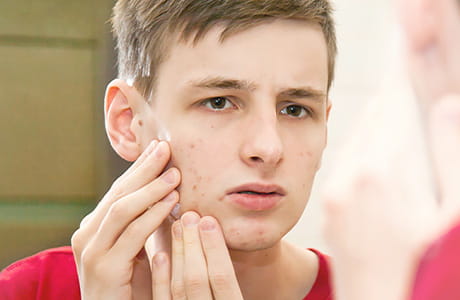What is psoriasis?
Symptoms of psoriasis, treatment options and when to see a doctor.
It starts as an itch. You put on some lotion and hope it goes away. But then you notice a flaky, scaly patch of skin — maybe it’s on your elbows, knees or scalp. Does the dryness have to do with your diet? The clothes you’re wearing? The weather?
Another possible cause: psoriasis, a skin condition that causes discomfort, itchiness and flakiness. While not common, psoriasis is easily treatable. Whether you want to try at-home remedies or you’re considering a dermatologist visit, there’s relief.
What is psoriasis?
When normally glowing and healthy skin turns scaly, red and irritated, what’s going on?
While there are eight types of psoriasis, the most common is plaque psoriasis, which causes the hallmark itchy, scaly rashes. The seven other types are far less common. The main signs and symptoms of plaque psoriasis to watch for:
- Red bumps with white scales
- Itching, burning or sore patches
- Elbows, knees, lower back and scalp are commonly affected
All these symptoms are caused by skin cells growing faster than usual. Dead skin cells move to the outer surface of the skin, creating patches and scales of white, flaky skin. But why is it so itchy?
Your body’s response to built-up skin is to remove the buildup — by scratching it off. And while scratching might give you temporary relief from the itch, it can damage your skin.
Your knees, elbows and scalp are among the most common areas for a psoriasis breakout, also known as a flare-up. However, it can also affect your torso, palms, lower back or the soles of your feet.
What are the different types of psoriasis?
If you don’t have plaque psoriasis, you may have guttate psoriasis. While its name sounds a little strange, guttate psoriasis is easily treated and is the second most common type of psoriasis.
“Guttate psoriasis affects younger populations and is typically triggered by an infection, such as strep throat. It usually appears as smaller, red scaly papules,” says Geisinger dermatologist Mary Brady, MD.
Three other major forms of psoriasis include:
- Inverse psoriasis: This causes smooth red blotches on the back of the knee, in the armpit or in the groin area.
- Pustular psoriasis: Patches of red skin surround white pustules of noninfectious pus.
- Erythrodermic psoriasis: This rare type of psoriasis turns most of the skin red and happens when plaque psoriasis becomes unstable.
Psoriasis is itchy and annoying, but should you see a dermatologist about it? The short answer is yes.
“If it takes up about 3% or less of your skin’s surface, you have a mild case of psoriasis. Between 3% and 10% is considered a moderate case, and 10% or above is severe,” Dr. Brady says. “If psoriasis is interfering with your day-to-day life or mental health, it’s time to find a treatment plan with a dermatologist.”
But itchy skin isn’t always psoriasis — it could be something else.
What’s the difference between psoriasis and eczema?
They’re both skin conditions. They both cause itchiness. They both lead to an abnormal skin appearance. So, what’s the difference between psoriasis and eczema?
Though it can be difficult to tell the two apart, there are a few clues. Look at the affected area of your skin. Is it scaly? Are there flakes? Or is it just red and raised?
Psoriasis typically results in more defined scaly skin, also known as plaques. Eczema, on the other hand, generally has finer scales and is less defined. Each condition also tends to appear on different parts of the body. Eczema is more likely to appear inside the elbows, behind the knees or on your hands or neck.
If you’re still unsure whether you have psoriasis or eczema, your best bet is to see a healthcare provider — ideally a dermatologist — to diagnose your skin condition.
What causes psoriasis?
Psoriasis can come and go throughout your life. You may have had it as a child and not had a flare-up in years, then notice it coming back. Or maybe this is the first time you’ve had it. Either way, knowing more about psoriasis could help you prevent future flare-ups.
While doctors don’t entirely know what causes flare-ups, they do know that immune systems and genetics play a big role. About a third of people who develop psoriasis have a family member who had it at some point in their life.
Find yourself having a flare-up during a big life event? Stress could be a factor. Work projects, moving, a loved one passing or a dramatic change in routine all lead to stress in your life. And because stress makes it hard for your body to regulate itself like it normally does, your psoriasis can flare up.
What is the best treatment for psoriasis?
Knowing the best ways to treat psoriasis can get you back to living a (relatively) itch-free and comfortable life.
You may have heard old wives’ tales that involve seed oils, essential oils, wraps and a host of other at-home remedies. But do they work?
Treatments for psoriasis are best determined by a healthcare professional, specifically a dermatologist. Because the condition can show up in a variety of forms, having a doctor diagnose and treat it is a good place to start.
Before your appointment, though, start paying attention to what sets off a flare-up.
“Along with stress, some of the triggers of psoriasis include certain medications, infections such as strep throat, or skin trauma like cuts, bug bites or new tattoos,” Dr. Brady says. “Psoriasis is also associated with heart disease, so it’s smart to check in with your primary care doctor.”
Treat psoriasis with over-the-counter moisturizers
When a flare-up is itchy, uncomfortable, hot or painful, you have options to alleviate it.
The first thing to do: Keep the affected area moisturized. Psoriasis flare-ups are often dry and result in dandruff (flaky skin — on your scalp or other body parts). By keeping the skin moisturized, you prevent cracking and further irritation.
While some moisturizers work better than others depending on your skin type and severity of your psoriasis, look for fragrance-free moisturizers. Cream or ointment tends to work better than lotion. Petroleum jelly ointment is another option.
Treat psoriasis with oatmeal baths
Oatmeal baths are a great low-cost treatment for psoriasis, especially when the patches cover large areas of your body. By turning oats into a colloidal solution — when the oats are ground finely enough to dissolve in water — and bathing with it, you can reduce inflammation and hydrate your skin.
While you can buy over-the-counter colloidal oatmeal cream, bath mix or lotion, all you really need is finely ground oatmeal and a warm bath.
Prepare a colloidal oatmeal bath by following these easy steps:
- Grind one to one-and-a-half cups of oatmeal in a blender until it’s nearly as fine as flour.
- Test to see if a teaspoon of your ground oatmeal dissolves in a glass of warm water. If it dissolves, with very little settling on the bottom, it’s fine enough.
- Draw a warm bath — take care that the water isn’t too hot, or it will irritate your skin.
- Pour the ground oatmeal into the bathtub and stir, making sure any sediment on the bottom of the tub gets mixed into the bathwater.
- Soak in the colloidal oatmeal solution for 10 to 15 minutes.
- Note: Colloidal oatmeal can make your bathtub slippery. Exit the tub with care and ask for help if needed.
Treat psoriasis with over-the-counter corticosteroids
A corticosteroid is a medication that reduces inflammation — the redness and rashes that accompany conditions like psoriasis. The most common over-the-counter corticosteroid is hydrocortisone. While a healthcare provider may prescribe stronger corticosteroids, hydrocortisone can quickly relieve the pain and itchiness of psoriasis.
Hydrocortisone is effective in treating small patches of psoriasis. If you don’t find relief or your psoriasis is widespread, consider seeing a healthcare provider to discuss other options, including a higher-strength corticosteroid.
Other treatments for psoriasis
Nothing’s working so far? Don’t despair — there’s a range of other treatments you can discuss with your healthcare provider. Remedies such as UV light therapy (also known as phototherapy) and dietary changes can help your psoriasis symptoms. In some severe cases, injections or IV infusions of certain medications may be recommended.
But try to keep moisturizing lotion and a humidifier handy, especially when the weather is cold and dry, to help prevent flare-ups. If you notice your psoriasis is persistent or worsening, consult a dermatologist to develop a treatment plan.
Your skin protects you, so return the favor — especially when you have psoriasis. Heading off flare-ups and seeing a dermatologist may just be the best rash decisions you’ve ever made.
Next steps:
Meet Mary Brady, MD
Learn about dermatology care at Geisinger
What is slugging?





